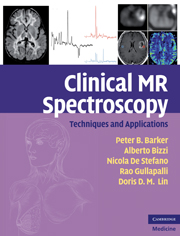Book contents
- Frontmatter
- Contents
- Preface
- Acknowledgments
- Abbreviations
- 1 Introduction to MR spectroscopy in vivo
- 2 Pulse sequences and protocol design
- 3 Spectral analysis methods, quantitation, and common artifacts
- 4 Normal regional variations: brain development and aging
- 5 MRS in brain tumors
- 6 MRS in stroke and hypoxic–ischemic encephalopathy
- 7 MRS in infectious, inflammatory, and demyelinating lesions
- 8 MRS in epilepsy
- 9 MRS in neurodegenerative disease
- 10 MRS in traumatic brain injury
- 11 MRS in cerebral metabolic disorders
- 12 MRS in prostate cancer
- 13 MRS in breast cancer
- 14 MRS in musculoskeletal disease
- Index
- References
4 - Normal regional variations: brain development and aging
Published online by Cambridge University Press: 04 August 2010
- Frontmatter
- Contents
- Preface
- Acknowledgments
- Abbreviations
- 1 Introduction to MR spectroscopy in vivo
- 2 Pulse sequences and protocol design
- 3 Spectral analysis methods, quantitation, and common artifacts
- 4 Normal regional variations: brain development and aging
- 5 MRS in brain tumors
- 6 MRS in stroke and hypoxic–ischemic encephalopathy
- 7 MRS in infectious, inflammatory, and demyelinating lesions
- 8 MRS in epilepsy
- 9 MRS in neurodegenerative disease
- 10 MRS in traumatic brain injury
- 11 MRS in cerebral metabolic disorders
- 12 MRS in prostate cancer
- 13 MRS in breast cancer
- 14 MRS in musculoskeletal disease
- Index
- References
Summary
Key points
Substantial regional variations in proton brain spectra exist; differences between gray and white matter, anterior–posterior gradients, and differences between the supra- and infra-tentorial brain are common.
Spectra change rapidly over the first few years of life; at birth, NAA is low, and choline and myo-inositol are high. By about 4 years of age, spectra from most regions have a more “adult-like” appearance.
In normal development, only subtle age-related changes are found between the ages of 4 and 20 years.
In normal aging, only subtle age-related changes are found. A recent meta-analysis indicated the most common findings are mildly increased choline and creatine in frontal brain regions of elderly subjects (> 68 years), and stable or slightly decreasing (parietal regions only) NAA.
Introduction
Interpretation of spectra from patients with neuropathology requires a knowledge of the normal regional and age-related spectral variations seen in the healthy brain. This is a difficult issue, since spectra are quite dependent on the technique used to record them (particularly choice of echo time, and field strength), and also show quite large regional and age-related (at least in young children) dependencies. However, while there still remain some gaps in the literature (e.g. detailed, regional studies in very young children), for the most part regional and age-related changes in brain spectra are now well-characterized. This chapter reviews what is known about regional metabolite variations, as well as metabolic changes associated with brain development, and aging.
- Type
- Chapter
- Information
- Clinical MR SpectroscopyTechniques and Applications, pp. 51 - 60Publisher: Cambridge University PressPrint publication year: 2009

